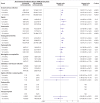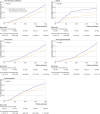Association between antenatal corticosteroids and risk of serious infection in children: nationwide cohort study
- PMID: 37532264
- PMCID: PMC10394679
- DOI: 10.1136/bmj-2023-075835
Association between antenatal corticosteroids and risk of serious infection in children: nationwide cohort study
Abstract
Objective: To investigate the associations between exposure to antenatal corticosteroids and serious infection in children during the first three, six, and 12 months of life.
Design: Nationwide cohort study.
Setting: National Health Insurance Research Database, Birth Reporting Database, and Maternal and Child Health Database, 1 January 2008 to 31 December 2019, to identify all pregnant individuals and their offspring in Taiwan.
Participants: 1 960 545 pairs of pregnant individuals and their singleton offspring. 45 232 children were exposed and 1 915 313 were not exposed to antenatal corticosteroids.
Main outcome measures: Incidence rates were estimated for overall serious infection, sepsis, pneumonia, acute gastroenteritis, pyelonephritis, meningitis or encephalitis, cellulitis or soft tissue infection, septic arthritis or osteomyelitis, and endocarditis during the first three, six, and 12 months of life in children exposed versus those not exposed to antenatal corticosteroids. Cox proportional hazards models were performed to quantify adjusted hazard ratios with 95% confidence intervals for each study outcome.
Results: The study cohort was 1 960 545 singleton children: 45 232 children were exposed to one course of antenatal corticosteroids and 1 915 313 children were not exposed to antenatal corticosteroids. The adjusted hazard ratios for overall serious infection, sepsis, pneumonia, and acute gastroenteritis among children exposed to antenatal corticosteroids were significantly higher than those not exposed to antenatal corticosteroids during the first six months of life (adjusted hazard ratio 1.32, 95% confidence interval 1.18 to 1.47, P<0.001, for overall serious infection; 1.74, 1.16 to 2.61, P=0.01, for sepsis; 1.39, 1.17 to 1.65, P<0.001, for pneumonia; and 1.35, 1.10 to 1.65, P<0.001, for acute gastroenteritis).Similarly, the adjusted hazard ratios for overall serious infection (P<0.001), sepsis (P=0.02), pneumonia (P<0.001), and acute gastroenteritis (P<0.001) were significantly higher from birth to 12 months of life. In the sibling matched cohort, the results were comparable with those observed in the whole cohort, with a significantly increased risk of sepsis in the first six (P=0.01) and 12 (P=0.04) months of life.
Conclusions: This nationwide cohort study found that children exposed to one course of antenatal corticosteroids were significantly more likely to have an increased risk of serious infection during the first 12 months of life. These findings suggest that before starting treatment, the long term risks of rare but serious infection associated with antenatal corticosteroids should be carefully weighed against the benefits in the perinatal period.
© Author(s) (or their employer(s)) 2019. Re-use permitted under CC BY-NC. No commercial re-use. See rights and permissions. Published by BMJ.
Figures



Comment in
-
Antenatal corticosteroids and longer term outcomes.BMJ. 2023 Aug 2;382:1722. doi: 10.1136/bmj.p1722. BMJ. 2023. PMID: 37532272 No abstract available.
References
-
- WHO recommendations on antenatal corticosteroids fro improving preterm birth outcomes. 2022. https://www.who.int/publications/i/item/9789240057296. - PubMed
MeSH terms
Substances
LinkOut - more resources
Full Text Sources
Other Literature Sources
Medical
